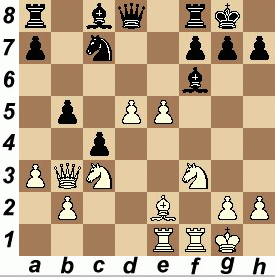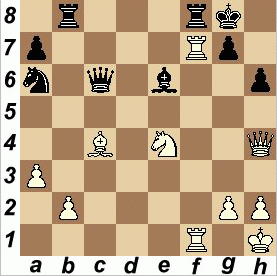2. d4,c5
3. c3,d5
4. exd5,Qxd5
After this unusual move order we have reached a c3 Sicilian with an early e6 by black. It should be noted that B could have played 4....exd5, when 5.Be3 c4 6.b3 should come into consideration.
5. Nf3,Nf6
6. Be2,Be7
7. 0-0,0-0
Since black is not willing to swap pawns in d4, as theory suggests, I now felt that it was necessary to push in c4; otherwise, white gets nothing out of the opening, since it would be time to develop the queen's knight but c3 is unavailable. The c4 push takes d5 away and prepares the natural development of white's QN, but opens the discussion on the ownership of the d4 square.
8. c4,Qd8
9. Nc3,Nc6
10. Be3,Ng4?!
When I played 8.c4 I had been a trifle worried of my judgement of this position. I had reached the conclusion that the loss of the bishop pair was fully compensated by the open f file, the passive BN, and the strong pawn center I would get, but I had not yet seen just how strong white's position would become...
11. d5!,Nxe3
12. fxe3,Nb4
13. a3,Na6
As a result of this sequence, B has already a bad position. Here 14.e4 was possible, and strong, but I wanted to develop the rest of my forces as soon as possible before enbarking in active play in the center. Black has little options here, anyways...
14. Qb3,Bf6
15. Rae1!?, Nc7
16. e4, b5
If 16....Qd6 I had prepared 17.e5! Bxe5 18.Nxe5 Qxe5 19. Bc4! and white dominates.
17. e5, c4?

Black should have played something else here, since this move loses a pawn for no compensation; it is difficult, however, to suggest a way to prevent white from obtaining a crushing attack. Note that now 18.Bxc4? would be bad, since 18....bxc4 (18....Bxe5 19.Nxe5 bxc4 20.Qxc4 +-) 19.Qxc4 Ba6, (19....Bh4? 20.Nxh4 Qxh4 21.Qxc7 +-) or even 19....Be7 20.d6 Bxd6 21.exd6 Qxd6 would solve black's problems.
18. Qb4!, Bh4
19. Nxh4, Qxh4
20. Qc5!, Na6
The Qb4-c5 manouver had probably been overlooked by B when he played 17....c4. Now things clear up and white's advantage is undisputable.
21. Qxb5, Qd4+
22. Kh1, Rb8
23. Qxc4, Qxe5
Now 24.Bd3 would be strong, but the move played is even more forcing since both Bd3 and Bxa6 are now threatened...
24. Qh4!,Qc7
25. Bd3, h6
One can hardly suggest 25.... g6, since the holes in f6 and h6 would mean mate in a few moves.
26. Re7, Qd6
27. Ne4!, Qxd5
28. Bc4, Qc6
Of course not 28....Qxc4, for 29.Nf6+ and white wins.
29. Rexf7, Be6

The crux of B in this position is still the Na6, which not only is totally out of play, but is a target of many tactics. In fact, W wins the game by capturing it. The following sequence is forced and brings to a completely winning position:
30. Rxf8+, Rxf8
31. Rxf8+, Kxf8
32. Qd8+, Kf7
Not 32....Qe8, since simply swapping queens and taking the Na6 is an easy win.
33. Nd6+!, Kg6
34. Bd3+, Kh5
35. Qa5+, Nc5
Only marginally better would have been 35....Bd5, when 36.Qxa6! (defending the back rank for 36....Qc1 37.Bf1 is safe) Bxg2+ 37.Kg1 wins easily.
36. Ne4, resign
A very good game for White I must say, and a good way to end the tournament, which had begun badly for me, with a loss due to a stupid blunder in a completely drawn position (Q+R vs Q+R, with 5 symmetrical pawns on their starting squares...) with Goran Mufic, a 2382 FM from Rijeka, and a draw in a completely winning position against a candidate master... In the end I scored 2.5/6, which is not too good but close to my expected score.